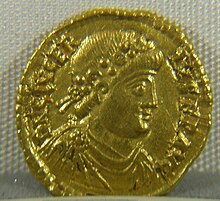
The Burgundians were an early Germanic tribe or group of tribes. They appeared east in the middle Rhine region in the third century AD, and were later moved west into the Roman Empire, in Gaul. In the first and second centuries AD they, or a people with the same name, were mentioned by Roman writers living west of the Vistula river in the region of Germania which is now part of Poland.
The 470s decade ran from January 1, 470, to December 31, 479.
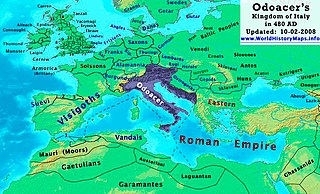
Year 480 (CDLXXX) was a leap year starting on Tuesday of the Julian calendar. At the time, it was known as the Year of the Consulship of Basilius without colleague. The denomination 480 for this year has been used since the early medieval period, when the Anno Domini calendar era became the prevalent method in Europe for naming years.
The 480s decade ran from January 1, 480, to December 31, 489.
The 450s decade ran from January 1, 450, to December 31, 459.

Year 452 (CDLII) was a leap year starting on Tuesday of the Julian calendar. At the time, it was known as the Year of the Consulship of Herculanus and Sporacius. The denomination 452 for this year has been used since the early medieval period, when the Anno Domini calendar era became the prevalent method in Europe for naming years.

Year 456 (CDLVI) was a leap year starting on Sunday of the Julian calendar. At the time, it was known as the Year of the Consulship of Avitus without colleague. The denomination 456 for this year has been used since the early medieval period, when the Anno Domini calendar era became the prevalent method in Europe for naming years.

Year 458 (CDLVIII) was a common year starting on Wednesday of the Julian calendar. At the time, it was known as the Year of the Consulship of Maiorianus and Leo. The denomination 458 for this year has been used since the early medieval period, when the Anno Domini calendar era became the prevalent method in Europe for naming years.
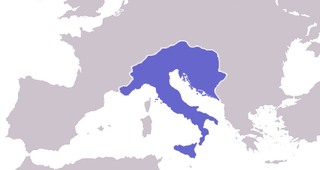
Year 493 (CDXCIII) was a common year starting on Friday of the Julian calendar. At the time, it was known as the Year of the Consulship of Albinus and Eusebius. The denomination 493 for this year has been used since the early medieval period, when the Anno Domini calendar era became the prevalent method in Europe for naming years.
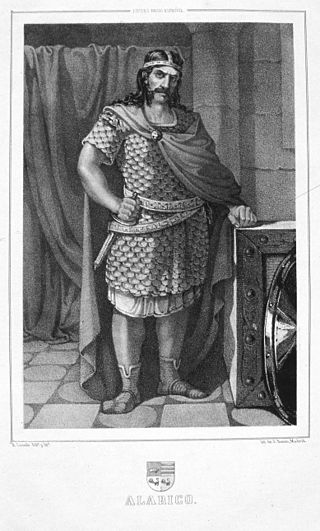
Year 484 (CDLXXXIV) was a leap year starting on Sunday of the Julian calendar. At the time, it was known as the Year of the Consulship of Venantius and Theodoricus. The denomination 484 for this year has been used since the early medieval period, when the Anno Domini calendar era became the prevalent method in Europe for naming years.

Year 474 (CDLXXIV) was a common year starting on Tuesday of the Julian calendar. At the time, it was known as the Year of the Consulship of Leo without colleague. The denomination 474 for this year has been used since the early medieval period, when the Anno Domini calendar era became the prevalent method in Europe for naming years.

Glycerius was Roman emperor of the West from 473 to 474. He served as comes domesticorum during the reign of Olybrius, until Olybrius died in November 472. After a four-month interregnum, Glycerius was proclaimed as emperor in March 473 by Gundobad, the magister militum and power behind the throne. Very few of the events of his reign are known other than that an attempted invasion of Italy by the Visigoths was repelled by local commanders, diverting them to Gaul. Glycerius also prevented an invasion by the Ostrogoths through diplomacy, including a gift of 2,000 solidi.

Julius Nepos, or simply Nepos, ruled as Roman emperor of the West from 24 June 474 to 28 August 475. After losing power in Italy, Nepos retreated to his home province of Dalmatia, from which he continued to claim the western imperial title, with recognition from the Eastern Roman Empire, until he was murdered in 480. Though Nepos' successor in Italy, Romulus Augustulus, is traditionally deemed the last western Roman emperor, Nepos is regarded by some historians as the true last emperor of the west, being the last widely recognised holder of the position.

Year 467 (CDLXVII) was a common year starting on Sunday of the Julian calendar. At the time, it was known as the Year of the Consulship of Pusaeus and Iohannes. The denomination 467 for this year has been used since the early medieval period, when the Anno Domini calendar era became the prevalent method in Europe for naming years.

Gundobad was King of the Burgundians (473–516), succeeding his father Gundioc of Burgundy. Previous to this, he had been a patrician of the moribund Western Roman Empire in 472–473, three years before its collapse, succeeding his uncle Ricimer. He is perhaps best known today as the probable issuer of the Lex Burgundionum legal codes, which synthesized Roman law with ancient Germanic customs. He was the husband of Caretene.
Placidia was a daughter of Valentinian III, Roman emperor of the West from 425 to 455, and from 454/455 the wife of Olybrius, who became western Roman emperor in 472. She was one of the last imperial spouses in the Roman west, during the Fall of the Western Roman Empire during Late Antiquity.
Gondioc, also called Gunderic and Gundowech, was a King of the Burgundians, succeeding his putative father Gunther in 436.
Chilperic II was the King of Burgundy from 473 until his death. Before that he co-ruled with his father Gondioc beginning in 463. He began his reign in 473 after the partition of Burgundy with his younger brothers Godegisel, Gundobad, and Godomar; he ruled from Valentia Julia (Valence) and his brothers ruled respectively from Geneva, Vienne, and Lyon.
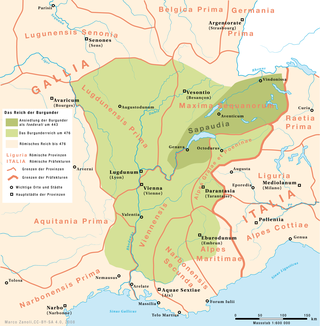
The Kingdom of the Burgundians, or First Kingdom of Burgundy, was established by Germanic Burgundians in the Rhineland and then in eastern Gaul in the 5th century.
